
| Version | Summary | Created by | Modification | Content Size | Created at | Operation |
|---|---|---|---|---|---|---|
| 1 | Adnan Shahid Khan | -- | 3889 | 2023-02-16 08:44:58 | | | |
| 2 | Lindsay Dong | + 6 word(s) | 3895 | 2023-02-17 02:27:53 | | | | |
| 3 | Lindsay Dong | Meta information modification | 3895 | 2023-02-17 02:28:12 | | |
Video Upload Options
In the 6G network, with blockchain and unmanned aerial vehicles (UAVs) authentication, the network decentralization and resource sharing would minimize resource under-utilization thereby facilitating PG targets. Furthermore, through an appropriate selection of blockchain type and consensus algorithms, the SG’s needs of UAV authentication in 6G network applications can also be readily addressed.
1. Introduction
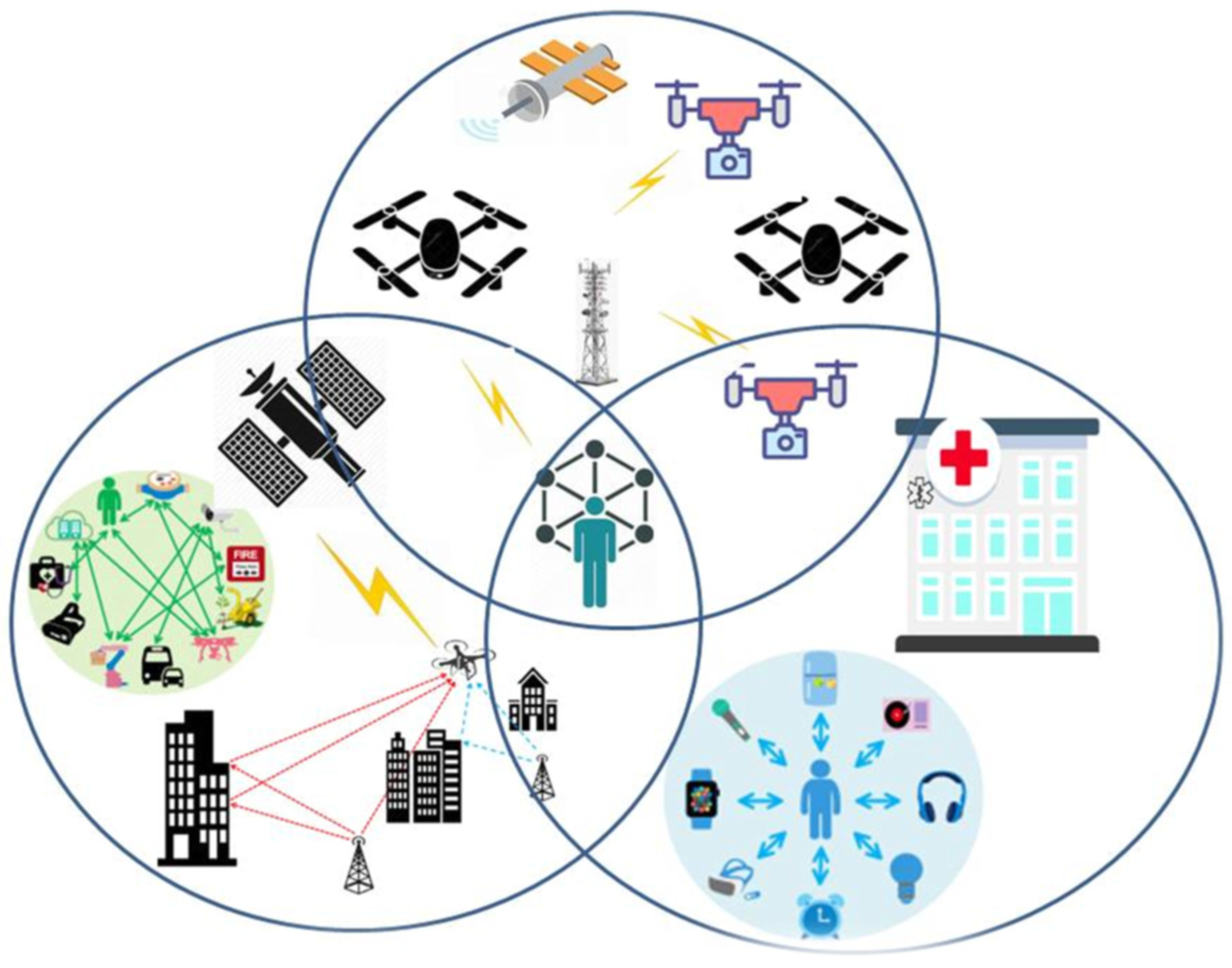
2. UAV Communication
Unmanned aerial vehicles (UAVs) have enormous potential in the universal domains including civil, defense, media and public domains [8]. They have unprecedented and useful applications where human lives can otherwise be in danger. In addition to this, multi UAV systems are jointly mission capable and can accomplish the same but better economy, precision and efficiency compared with solo UAV systems. However, there are many concerns that are required to be resolved before the effective use of unmanned aerial vehicles for the provision of reliable, assured and context-focused networks. In view of the distinctive characteristics of the UAV networks and the need to address related issues, considerable work is yet to be carried out in this area. Current progress in the domain of mobile adhoc networks (MANETs) and vehicular adhoc networks (VANETS) is not sufficient to address the peculiar nature of UAV networks. UAV networks may vary from slow dynamic to dynamic as some have intermittent links and topology that is relatively fluid.
2.1. Characterizing the UAV Network
2.1.1. Multi UAV Network
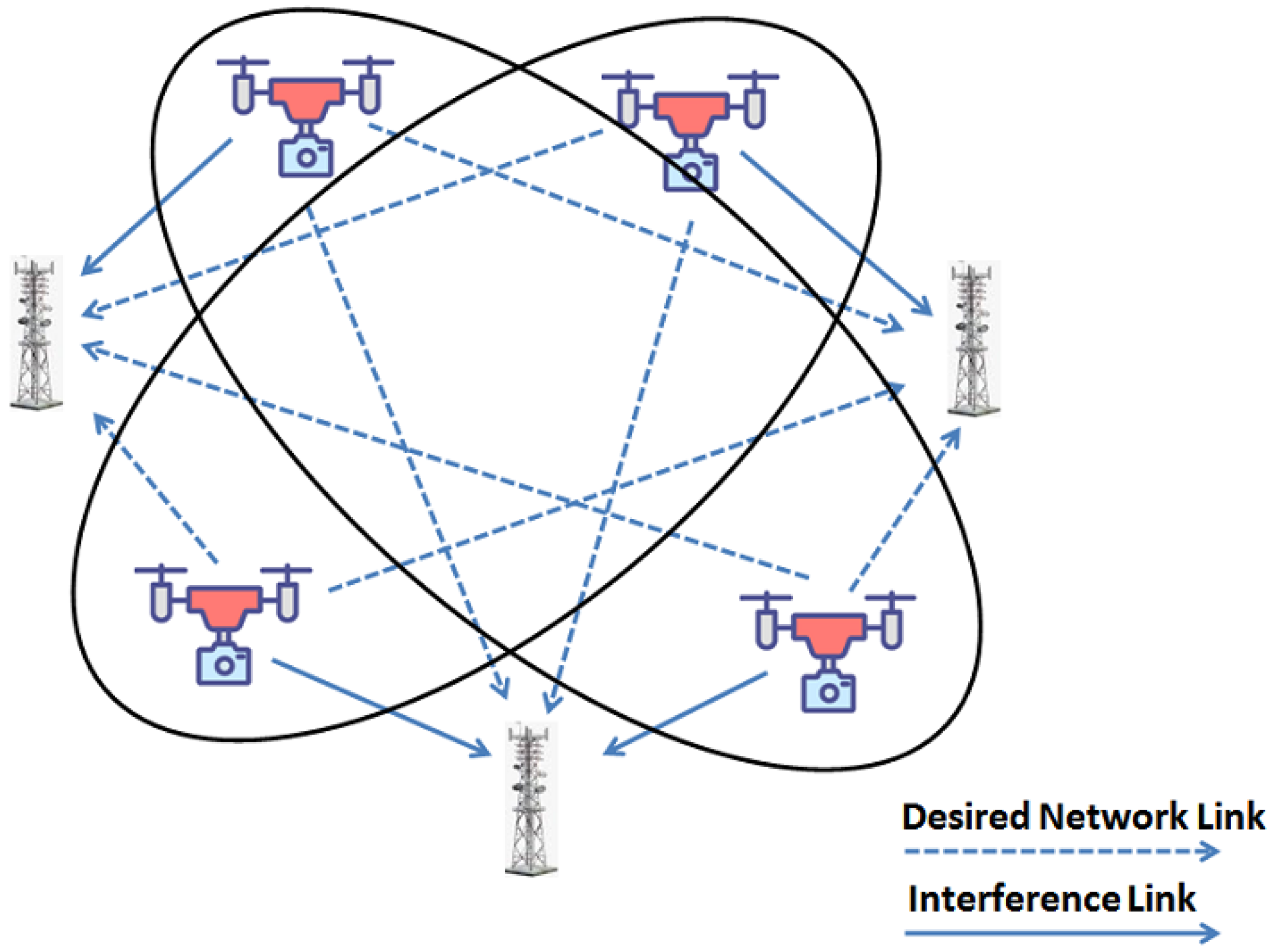
2.1.2. Infrastructure-Based or Adhoc UAV Networks
2.1.3. Server or Client?
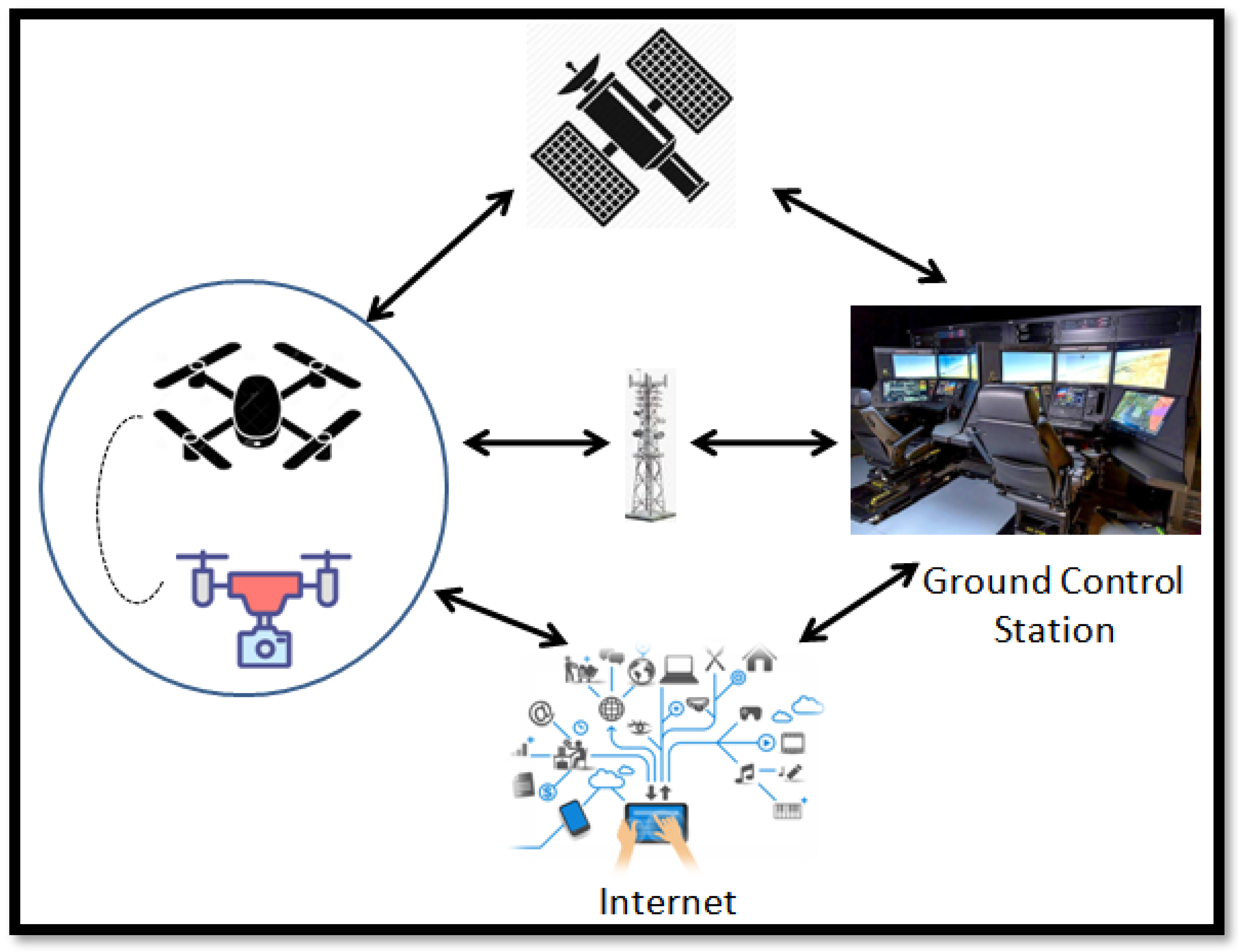
2.1.4. Star or Mesh?
2.2. Security in UAV Communication
3. UAV 6G Networks
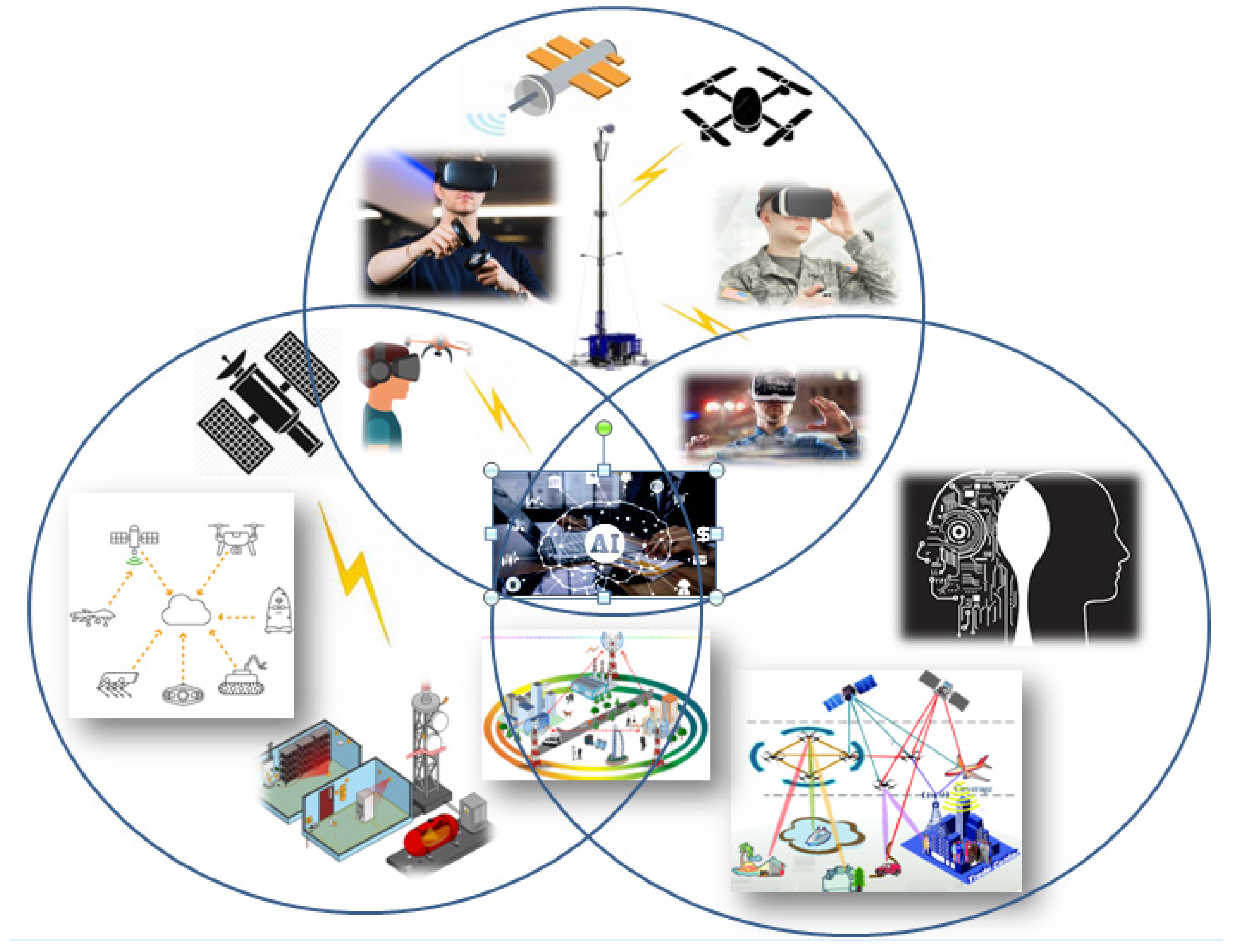
3.1. 6G Applications
3.2. 6G Application Requirements
With the goal of making blockchain utility more understandable, 6G applications are separated into two major groups. Ultra-reliability, low latency, increased data speeds and huge connection are among the typical criteria. I view of the pertinent factor in almost entire wireless communication generations, these needs are made part of the first category. These are referred as Qualification Group-I (QG-I). QG-I standards necessitate considerable improvement for potential 6G applications. The prime features for any reliable and secure network include non-reputability, confidentiality, defined level of secrecy, data integrity and auditability. These features are catered in second group named Qualification Group-II (QG-II).
3.2.1. High-Precision Positioning and Seamless Coverage
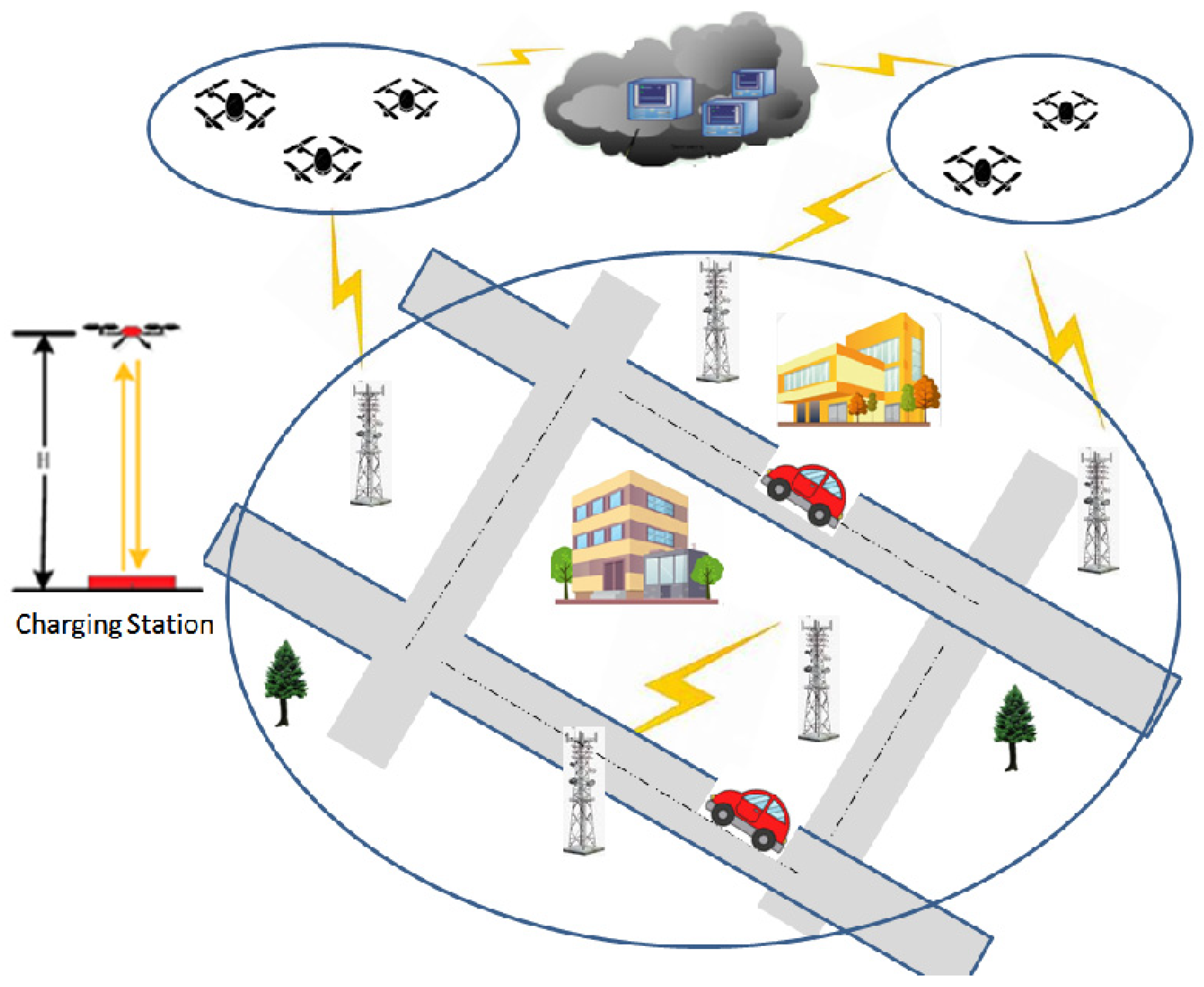
3.2.2. Remote and Real-Time Control (RRC)
3.2.3. Multimedia Transmission
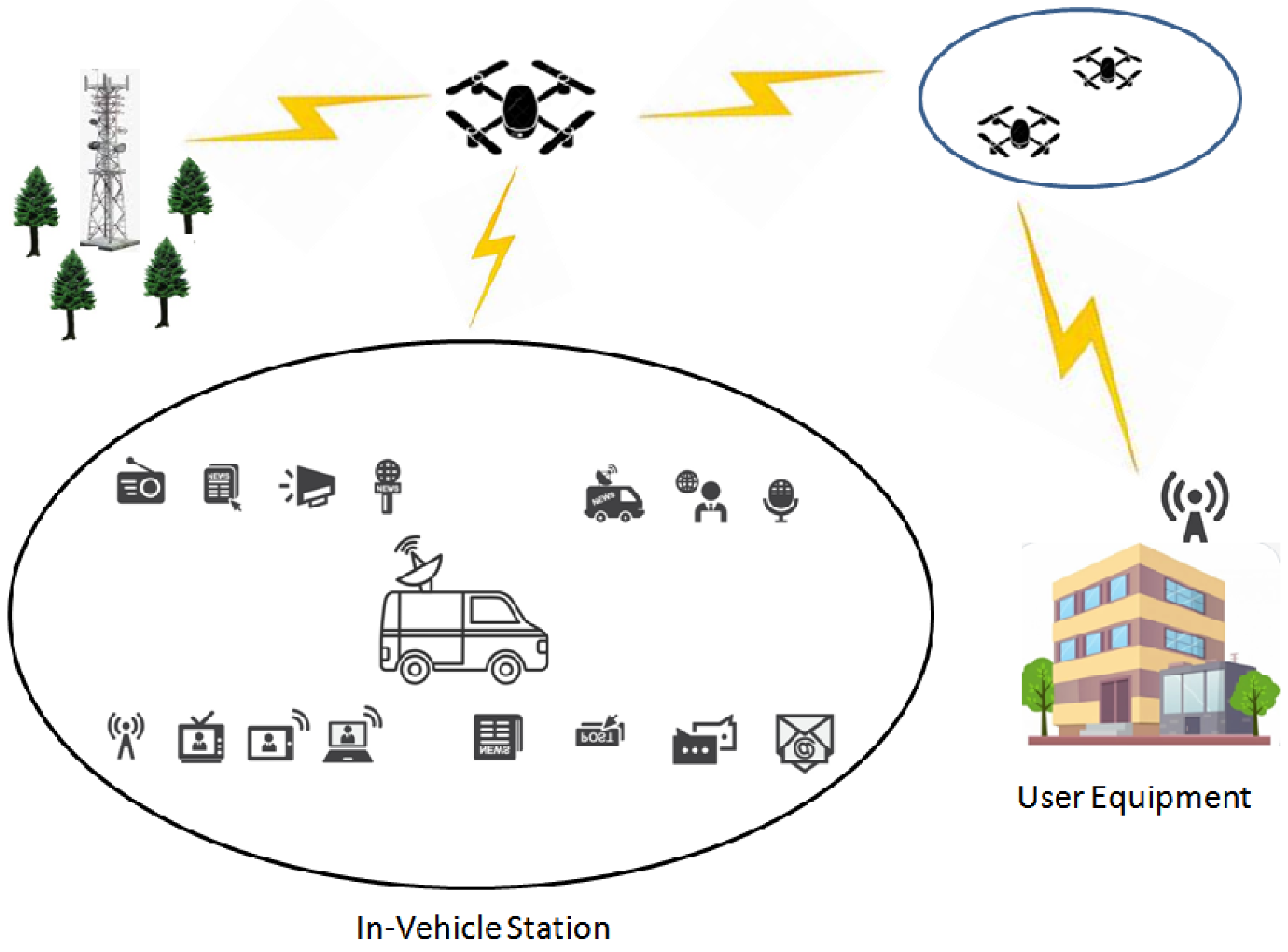
3.2.4. Aircraft Identification and Regulation
4. Authentication in UAV Networks
4.1. Light Weight Authentication Protocols
4.2. 6G Enabled Light Weight Authentication Protocols
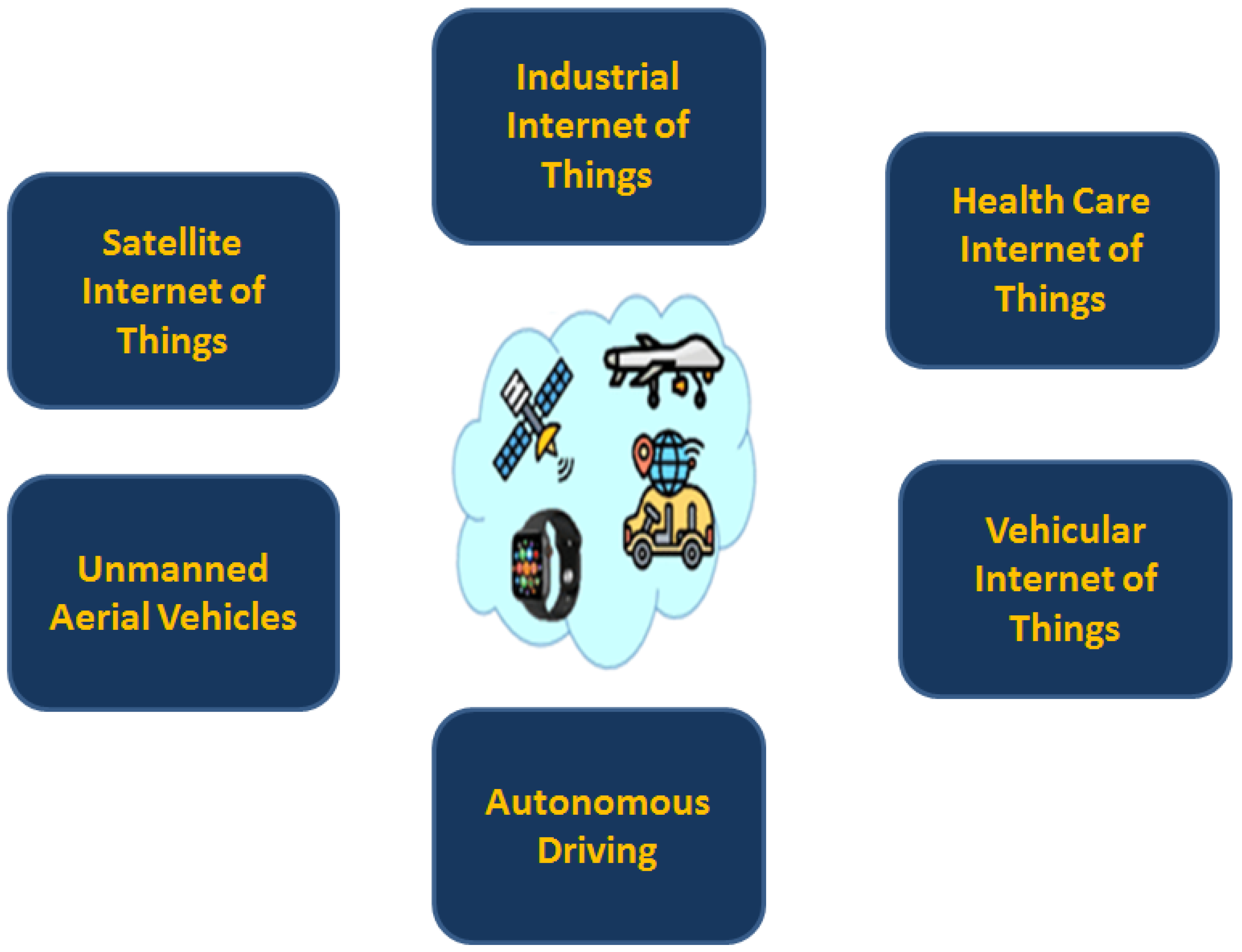
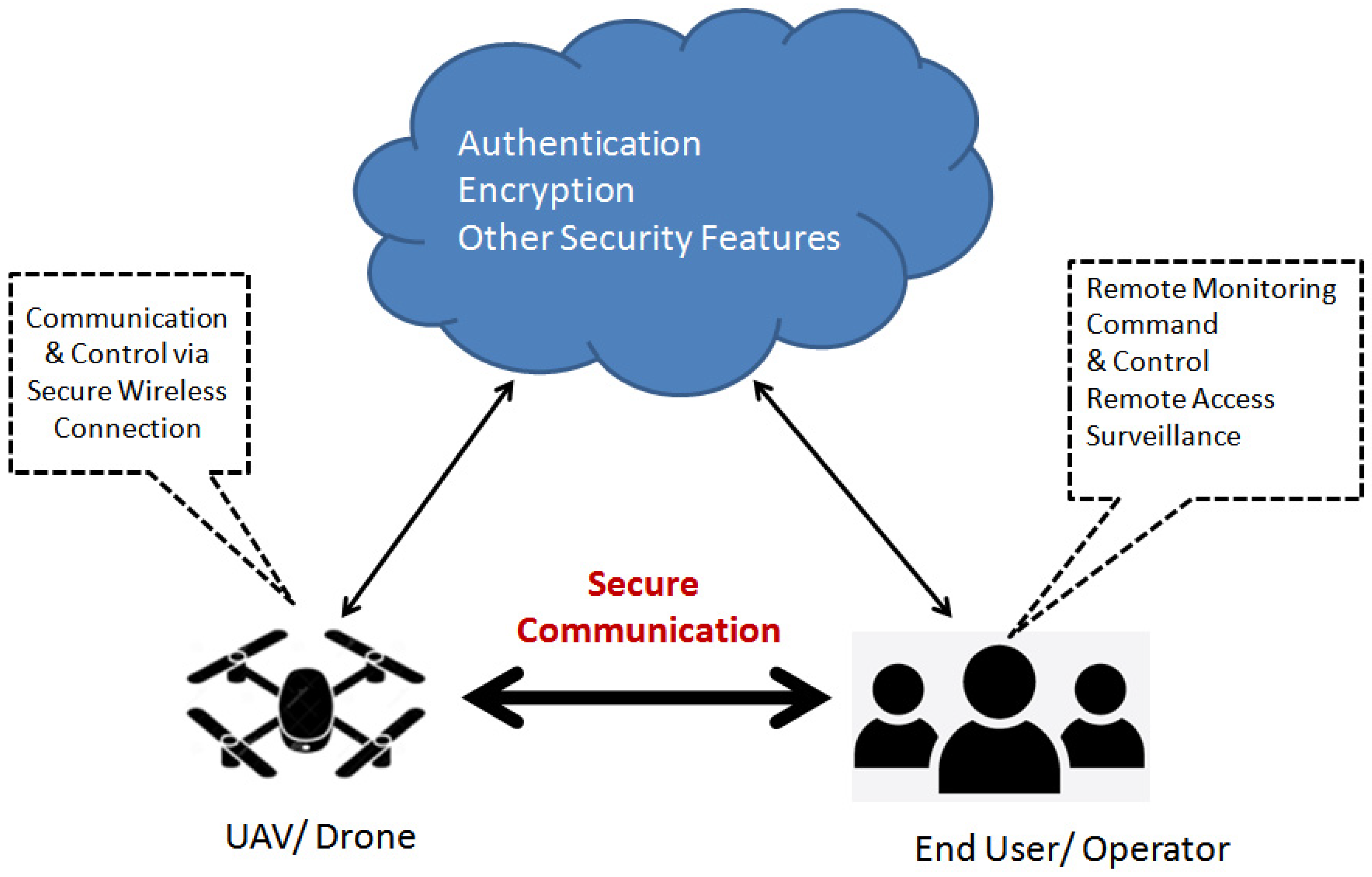
References
- Popovski, P.; Chiariotti, F.; Huang, K.; Kalør, A.; Kountouris, M.; Pappas, N.; Soret, B. A perspective on time toward wireless 6G. Proc. IEEE 2022, 110, 1116–1146.
- Khan, A.; Javed, Y.; Abdullah, J.; Nazim, J.; Khan, N. Security issues in 5G device to device communication. Int. J. Comput. Sci. Netw. Secur. 2017, 17, 366.
- Premkumar, R.; Priya, S.S. Blockchain and Internet of Things: Applications and practices. In Proceedings of the 2021 International Conference on Artificial Intelligence and Smart Systems (ICAIS), Pichanur, India, 25–27 March 2021; pp. 1376–1380.
- Gupta, R.; Nair, A.; Tanwar, S.; Kumar, N. Blockchain-assisted secure UAV communication in 6G environment: Architecture, opportunities, and challenges. IET Commun. 2021, 15, 1352–1367.
- Moşteanu, N.; Faccia, A. Digital Systems and New Challenges of Financial Management–FinTech, XBRL, Blockchain and Cryptocurrencies. Qual.-Access Success J. 2020, 21, 159–166.
- Khan, A.S.; Balan, K.; Javed, Y.; Tarmizi, S.; Abdullah, J. Secure trust-based blockchain architecture to prevent attacks in VANET. Sensors 2019, 19, 4954.
- Safdar, H.; Fisal, N.; Ullah, R.; Maqbool, W.; Asraf, F.; Khalid, Z.; Khan, A. Resource allocation for uplink M2M communication: A game theory approach. In Proceedings of the 2013 IEEE Symposium on Wireless Technology & Applications (ISWTA), Kuching, Malaysia, 22–25 September 2013; pp. 48–52.
- Kazmi, S.H.A.; Masood, A.; Nisar, K. Design and Analysis of Multi Efficiency Motors Based High Endurance Multi Rotor with Central Thrust. In Proceedings of the 2021 IEEE 15th International Conference on Application of Information and Communication Technologies (AICT), Baku, Azerbaijan, 13–15 October 2021; pp. 1–4.
- Raja, G.; Anbalagan, S.; Ganapathisubramaniyan, A.; Selvakumar, M.S.; Bashir, A.K.; Mumtaz, S. Efficient and secured swarm pattern multi-UAV communication. IEEE Trans. Veh. Technol. 2021, 70, 7050–7058.
- Li, T.; Hu, H. Development of the Use of Unmanned Aerial Vehicles (UAVs) in Emergency Rescue in China. Risk Manag. Healthc. Policy 2021, 14, 4293.
- Zhu, K.; Han, B.; Zhang, T. Multi-UAV Distributed Collaborative Coverage for Target Search Using Heuristic Strategy. Guid. Navig. Control 2021, 1, 2150002.
- Khan, I.U.; Shah, S.B.H.; Wang, L.; Aziz, M.A.; Stephan, T.; Kumar, N. Routing protocols & unmanned aerial vehicles autonomous localization in flying networks. Int. J. Commun. Syst. 2021, e4885.
- Nagpal, S.; Aggarwal, A.; Gaba, S. Privacy and Security Issues in Vehicular Ad Hoc Networks with Preventive Mechanisms. In Proceedings of the International Conference on Intelligent Cyber-Physical Systems; Springer: Singapore, 2022; pp. 317–329.
- El Haber, E.; Alameddine, H.A.; Assi, C.; Sharafeddine, S. UAV-aided ultra-reliable low-latency computation offloading in future IoT networks. IEEE Trans. Commun. 2021, 69, 6838–6851.
- Yahuza, M.; Idris, M.Y.I.; Ahmedy, I.B.; Wahab, A.W.A.; Nandy, T.; Noor, N.M.; Bala, A. Internet of drones security and privacy issues: Taxonomy and open challenges. IEEE Access 2021, 9, 57243–57270.
- Jan, S.U.; Abbasi, I.A.; Algarni, F.; Khan, A.S. Corrections to “A Verifiably Secure ECC Based Authentication Scheme for Securing IoD Using FANET”. IEEE Access 2022, 10, 105496.
- Lei, Y.; Zeng, L.; Li, Y.-X.; Wang, M.-X.; Qin, H. A lightweight authentication protocol for UAV networks based on security and computational resource optimization. IEEE Access 2021, 9, 53769–53785.
- Oteafy, S.M. Resource augmentation in Heterogeneous Internet of Things via UAVs. In Proceedings of the 2021 IEEE Global Communications Conference (GLOBECOM), Madrid, Spain, 7–11 December 2021.
- Gandra, C.; Hansson, J. Application of Value Proposition Design to a High-Tech Business Market Product; Lund University: Lund, Sweden, 2021.
- Baltaci, A.; Dinc, E.; Ozger, M.; Alabbasi, A.; Cavdar, C.; Schupke, D. A Survey of Wireless Networks for Future Aerial Communications (FACOM). IEEE Commun. Surv. Tutor. 2021, 23, 2833–2884.
- Zhang, T.; Wang, Z.; Liu, Y.; Xu, W.; Nallanathan, A. Joint Resource, Deployment, and Caching Optimization for AR Applications in Dynamic UAV NOMA Networks. IEEE Trans. Wirel. Commun. 2021, 21, 3409–3422.
- Kaiser, M.S.; Zenia, N.; Tabassum, F.; Mamun, S.A.; Rahman, M.A.; Islam, M.; Mahmud, M. 6G access network for intelligent internet of healthcare things: Opportunity, challenges, and research directions. In Proceedings of the International Conference on Trends in Computational and Cognitive Engineering; Springer: Singapore, 2021; pp. 317–328.
- Hamza, B.J.; Saad, W.K.; Shayea, I.; Ahmad, N.; Mohamed, N.; Nandi, D.; Gholampour, G. Performance enhancement of SCM/WDM-RoF-XGPON system for bidirectional transmission with square root module. IEEE Access 2021, 9, 49487–49503.
- Mitkas, D.Z.; Lovell, D.J.; Venkatesh, S.; Young, S. Activity Identification using ADS-B data at General Aviation Airports. In Proceedings of the AIAA AVIATION 2021 FORUM, Virtual Event, 2–6 August 2021.
- Ahmad, Z.; Shahid Khan, A.; Wai Shiang, C.; Abdullah, J.; Ahmad, F. Network intrusion detection system: A systematic study of machine learning and deep learning approaches. Trans. Emerg. Telecommun. Technol. 2021, 32, e4150.
- Munusamy, R.; Kumre, J.; Chaturvedi, S.; Bandhu, D. Design and Development of Portable UAV Ground Control and Communication Station Integrated with Antenna Tracking Mechanism. In Intelligent Infrastructure in Transportation and Management; Springer: Singapore, 2022; pp. 193–212.
- Adnan, W.H.; Khamis, M.F. Drone use in military and civilian application: Risk to national security. J. Media Inf. Warf. 2022, 15, 60–70.
- Mohammed, I.; Collings, I.B.; Hanly, S.V. Line of sight probability prediction for UAV communication. In Proceedings of the 2021 IEEE International Conference on Communications Workshops (ICC Workshops), Montreal, QC, Canada, 14–23 June 2021; pp. 1–6.
- Tang, S.; Zhou, W.; Chen, L.; Lai, L.; Xia, J.; Fan, L. Battery-constrained federated edge learning in UAV-enabled IoT for B5G/6G networks. Phys. Commun. 2021, 47, 101381.
- Sehrawat, H.; Siwach, V. Security vulnerabilities in Wireless Sensor Networks. J. Inf. Assur. Secur. 2010, 5, 31–44.
- Javed, Y.; Khan, A.S.; Qahar, A.; Abdullah, J. Preventing DoS attacks in IoT using AES. J. Telecommun. Electron. Comput. Eng. (JTEC) 2017, 9, 55–60.
- Nazir, M.; Sabah, A.; Sarwar, S.; Yaseen, A.; Jurcut, A. Power and resource allocation in wireless communication network. Wirel. Pers. Commun. 2021, 119, 3529–3552.
- Ly, B.; Ly, R. Cybersecurity in unmanned aerial vehicles (UAVs). J. Cyber Secur. Technol. 2021, 5, 120–137.
- Chierici, A.; Malizia, A.; Di Giovanni, D.; Ciolini, R.; d’Errico, F. A High-Performance Gamma Spectrometer for Unmanned Systems Based on Off-the-Shelf Components. Sensors 2022, 22, 1078.
- Maikol, S.O.; Khan, A.S.; Javed, Y.; Bunsu, A.L.A.; Petrus, C.; George, H.; Jau, S. A novel authentication and key agreement scheme for countering MITM and impersonation attack in medical facilities. Int. J. Integr. Eng. 2021, 13, 127–135.
- Balan, K.; Abdulrazak, L.; Khan, A.; Julaihi, A.; Tarmizi, S.; Pillay, K.; Sallehudin, H. RSSI and public key infrastructure based secure communication in autonomous vehicular networks. Int. J. Adv. Comput. Sci. Appl. 2018, 9, 298–304.
- Mahmood Saqib, R.; Shahid Khan, A.; Javed, Y.; Ahmad, S.; Nisar, K.; Abbasi, I.A.; Haque, M.R.; Ahmadi Julaihi, A. Analysis and intellectual structure of the multi-factor authentication in information security. Intell. Autom. Soft Comput. 2022, 32, 1633–1647.
- Memon, S.K.; Nisar, K.; Hijazi, M.H.A.; Chowdhry, B.; Sodhro, A.H.; Pirbhulal, S.; Rodrigues, J.J. A survey on 802.11 MAC industrial standards, architecture, security & supporting emergency traffic: Future directions. J. Ind. Inf. Integr. 2021, 24, 100225.
- Uribe-Leitz, T.; Matsas, B.; Dalton, M.K.; Lutgendorf, M.A.; Moberg, E.; Schoenfeld, A.J.; Goralnick, E.; Weissman, J.S.; Hamlin, L.; Cooper, Z. Geospatial analysis of access to emergency cesarean delivery for military and civilian populations in the US. JAMA Netw. Open 2022, 5, e2142835.
- Talpur, M.R.H.; Talpur, M.S.H.; Talpur, F.; Haseeb, A.; Kehar, A.; Fatima, S. A Model for Secure Inter-Institutional Communication Based on Artificial Intelligence (AI) and Blockchain. Int. J. Comput. Intell. Control 2021, 13, 145–154.
- Javed, Y.; Khan, A.S.; Qahar, A.; Abdullah, J. EEoP: A lightweight security scheme over PKI in D2D cellular networks. J. Telecommun. Electron. Comput. Eng. (JTEC) 2017, 9, 99–105.
- Deebak, B.D.; Fadi, A.-T. Lightweight authentication for IoT/Cloud-based forensics in intelligent data computing. Future Gener. Comput. Syst. 2021, 116, 406–425.
- Lafta, S.A.; Abdulkareem, M.M.; Ibrahim, R.K.; Kareem, M.M.; Ali, A.H. Quality of service performances of video and voice transmission in universal mobile telecommunications system network based on OPNET. Bull. Electr. Eng. Inform. 2021, 10, 3202–3210.
- Chaudhry, S.A.; Irshad, A.; Khan, M.A.; Khan, S.A.; Nosheen, S.; AlZubi, A.A.; Zikria, Y.B. A Lightweight Authentication Scheme for 6G-IoT Enabled Maritime Transport System. IEEE Trans. Intell. Transp. Syst. 2021.
- Pothumarti, R.; Jain, K.; Krishnan, P. A lightweight authentication scheme for 5G mobile communications: A dynamic key approach. J. Ambient Intell. Humaniz. Comput. 2021, 1–19.




